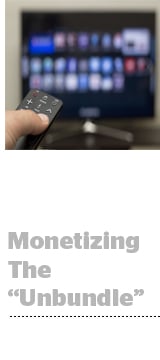 Catering to cord-cutters, cable networks and broadcasters are unbundling their content.
Catering to cord-cutters, cable networks and broadcasters are unbundling their content.
CBS, HBO and Viacom will all roll out paid subscription services. Ex-Hulu CEO Jason Kilar is launching both a subscription-based and ad-supported web video service, Vessel. And paid TV service Dish is rolling out Sling TV, a $20-per-month streaming service that gives subscribers AMC, ESPN, Cartoon Network, CNN, Food Network and other channels.
Despite the trend toward “TV Everywhere,” there are also new challenges, notably around ad creative and measurement.
“What I hate about some content deals is they don’t ever think about advertisers,” said Tracey Scheppach, senior vice president of precision video and innovation at Starcom MediaVest Group. “You want frequency caps so you don’t see the same ad 50 times and you want it to be relevant to what you’re watching.”
However, this is challenging to pull off if content is broadcast on traditional TV, web portals, apps and connected TV environments.
Rich Greenfield, managing director and media and technology analyst for global equity firm BTIG, noted this lack of data continuity within the TV Everywhere ecosystem.
“When you sign into WatchABC or WatchESPN, you are not getting a tailored content experience based on your personal interests,” Greenfield wrote in a recent research note following a video panel discussion at AdExchanger’s Industry Preview show in January. “In fact, you can use apps like WatchABC without even logging into the app itself.”
Even if a consumer authenticates, content providers aren’t always collecting and leveraging that information.
“Our player is not collecting, for example, your email address unless you provide it. And we’re not actively targeting against that data,” said Pooja Midha, senior VP of digital ad sales for Disney ABC TV Group, during an Industry Preview panel.Additionally, non-universal logins could potentially detract from the consumer experience, which is why broadcaster NBCUniversal tasked a TV Everywhere team with solving user experience challenges associated with cross-platform content and advertising.
Monetizing Tiered TV Content
The problem with TV Everywhere from the advertiser’s perspective is that it creates a hierarchy around content that didn’t used to exist.
AdExchanger Daily
Get our editors’ roundup delivered to your inbox every weekday.
Daily Roundup
For instance, the Tennis Channel has an array of programming arrangements with a number of carriers like DISH Network TV, DirecTV and Comcast. Tennis Channel also serves up a Tennis Channel Everywhere app and a new over-the-top subscription channel, Tennis Channel Plus, which is used as a cross-promotional opportunity for its standard digital and mobile properties.
Is inventory across all these channels worth the same? Networks aren’t sure yet. Right now, advertising in a TV Everywhere environment is more about potential.
“We see TV Everywhere as a basis to deliver other products and ad opportunities,” said Adam Ware, the Tennis Channel’s SVP of digital media, at the TV Of Tomorrow Show’s over-the-top TV production panel in New York this winter, but added that advertisers are rightfully confused about getting an accurate read on reach across multiple platforms.
“People talk impressions, completed views and time spent,” Ware said, but unified cross-platform measurement still lags.
Measurement technology is only partially a problem, and one that might be better addressed in a year, assuming comScore and Nielsen enhance cross-device measuring capabilities.
But beyond measurement, content providers are sometimes stymied by existing silos in the chain of command both at the network and agency level, which makes it hard to deliver on new creative or to gain access to vaunted audience data.
At this early stage, most ads shown on TV Everywhere products are direct sold and serve as way to test the waters with new content. After all, there needs to be an audience in order to attract new advertisers.
It remains to be seen, though, whether consumers want to see ads in these new unbundled environments in the first place.
“It goes back to the consumer,” Starcom MediaVest’s Scheppach said. “I don’t always want to pay X amount [for a subscription upsell]. In some cases I’d rather see five ads related to [tennis] near Chicago, where I live.”













